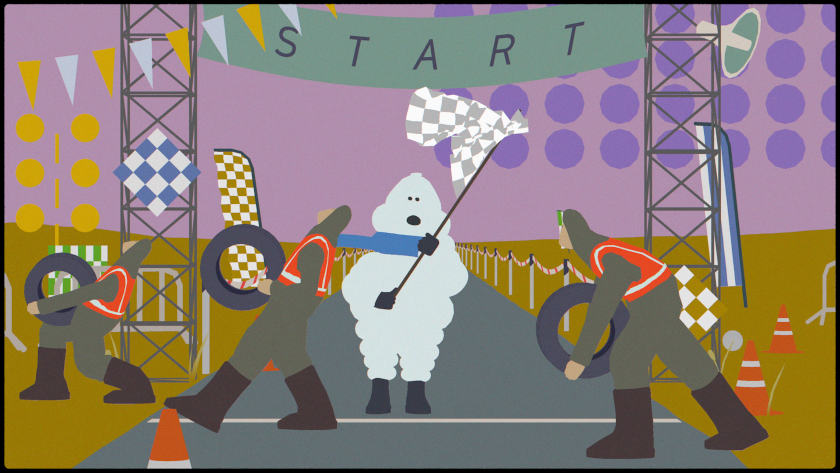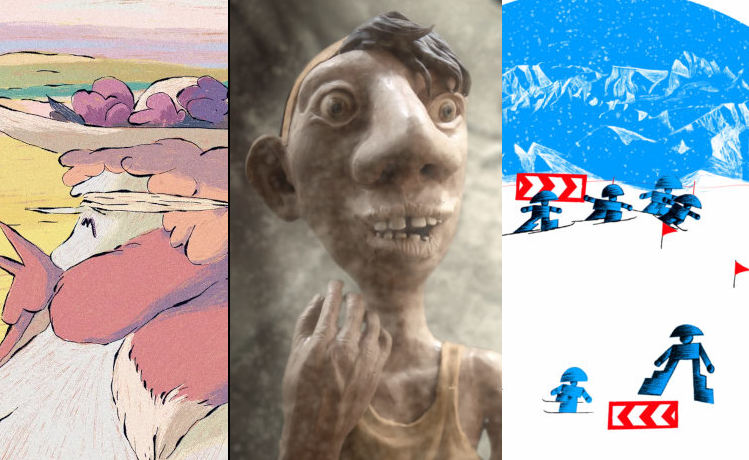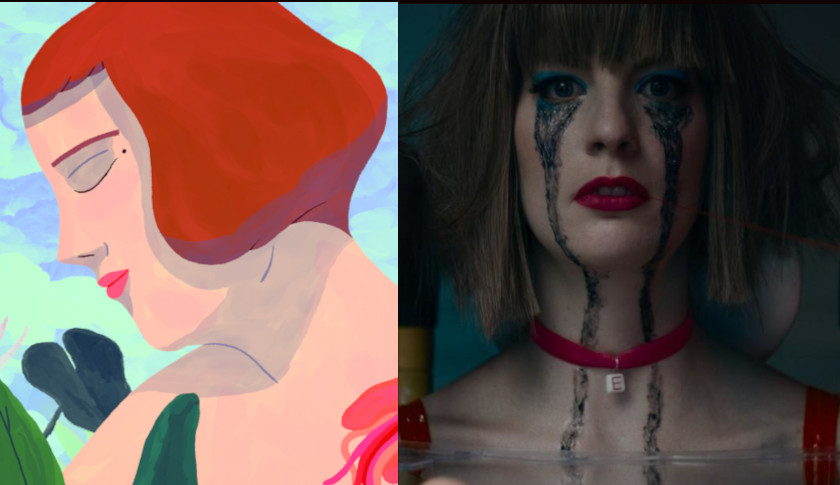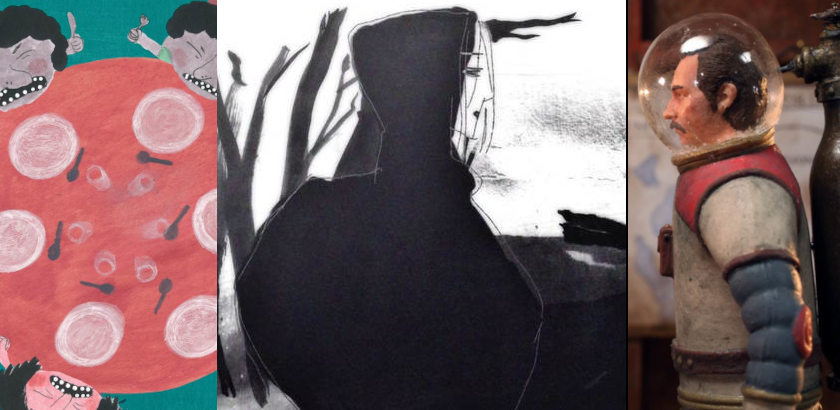Working In A Garden of Ideas: Interview with Tomek Popakul on the Animation Short 'Zima' co-directed with Kasumi Ozeki
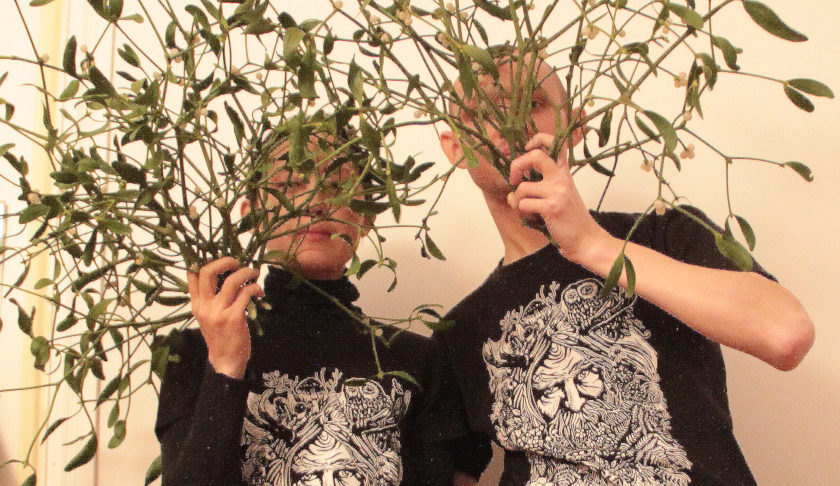
Tomek Popakul is one of those Polish animation talents who continuously draft complete animation worlds, mainly in his 'Ziegenort' and 'Acid Rain' films ('Acid Rain' topped our 2019 Best Animation Shorts poll).
In his latest, Oscar-qualifying 'Zima' (Winter) short, he co-directed with Kasumi Ozeki a Xmas story in a small fisherman's village, in which the usual relationship of animals and humans is being reversed. A production of Yellow Tapir films (co-produced by EC1 Łódź - Miasto Kultury, a Polish Film Institute co-financed production), the film went to several awards, starting from the Krakow Film Festival (Golden Dragon), and moving on winning Best Narrative Short at OIAF 2023, the Grand Prix at Etiuda & Anima Festival.
There's much to learn about this immersive and always engrossing film. The directors talked to Zippy Frames:
ZF: Zima is another complex, all-engrossing film, after 'Ziegenort' and 'Acid Rain'. Do you have multiple inspirations for this kind of story or did a single incident make you elaborate things in your head (and paper)?
TP: Yes, there were multiple inspirations for this movie, but most of them had the common core in my memories and experiences of winter in my village, people, and places I know. The story of 'Zima' is a patchwork of at least four separate story sketches that I had. One is about a so-called 'cat island' on a lagoon by my village, where supposedly unwanted kittens were dropped by fishermen instead of being killed by sinking them in the bag into a ditch with water. The second one was about a dog on a chain and his master. Keeping a dog on a chain was quite common in villages till recent years.
The third one was about a girl treating the church commandment 'to love Jesus' in quite a literal but pure way. The fourth one was the expansion of my memory when during Christmas time there was no electricity for four days, and the village was covered in pitch-darkness, and we felt that we were about to freeze in our house (our modernized furnace required electricity to function). I noticed that the common motif of all those stories is 'winter' so I tried to stick and overlap them together, and I saw they pretty nicely matched each other, but not perfectly, which is what we wanted because we were trying to make a detour from my usual straightforward narration and story-telling.
ZF: Relatedly, did you work on the script from beginning to end in the development stage? Or did you have time for improvisation in the actual production stage?
TP: I call my method of working on script 'ideas garden' - I let my ideas grow inside of my head over the years. I let them grow wild, just pouring them from time to time. When it's time to make a new movie, I go to my ideas garden to see which of the ideas are most ripe, ready to harvest. So I would say my work on script is rather organic, I don't write very rigid and precise structures or plans. I value as many possibilities of developments and inserts into the story as possible during the production process, to let the movie change as I change while living while I'm making the movie. I value consulting the script with one (not many!) trusted person, in this case, Kasumi Ozeki, when I have doubts and my intuition feels weaker than usual.
Watch the 'Zima' (Winter) trailer:
ZF: How important was it for you to include the religious element in the film, especially represented by a young girl (and Jesus devotee)?
TP: I grew up in a Polish village, where it's very hard to move around without stepping into some traces of catholicism, it's in mainstream culture, school, and folk tales. As much as I don't perceive myself as Catholic, I grew up with my catholic cousins, so their way of perceiving the world was very familiar and natural to me. Spirituality, cults, and religions of the world are very interesting to me, including Christianity, which I perceive as a very paradoxical, surreal, and cruel universe of belief, and I feel it's a nice opportunity for me to rediscover something so obvious for me living in Poland. If I believe in God, I would say he doesn't inhabit the building, I think the forest is the real cathedral, which is maybe closest to the pantheistic worldview.
However - religious elements in my movie are treated very very loosely, and it's not some theological thesis. Religious elements in 'Zima' refer more to folklore and customs of common people, which officially follow the teaching of the church, but make use of it for their purposes. The priest character is inspired by one priest from my village, the same as the altar boy. Church is a mix of my church and the church in the village of my friend etc. I feel a similar approach in another animated short "Such miracles do happen" by my fellow Polish animation director Basia Rupik.
But I didn't want to make this movie neither pro nor against religion - I wanted to pass the story of two main characters: Anka and Łukasz. Despite the story being soaked in a Polish environment, by working with Kasumi Ozeki I feel I can connect to some core issues of every human being, outside of cultural context. For example, recently 'Zima' was well received at the Feinaki festival in China, while the concept of monotheistic 'God' is not very clear to Asian audiences. I hope there is a chunky layer of story that is universal. Some say after all we are all the same humans, I would say after all we are all animals.
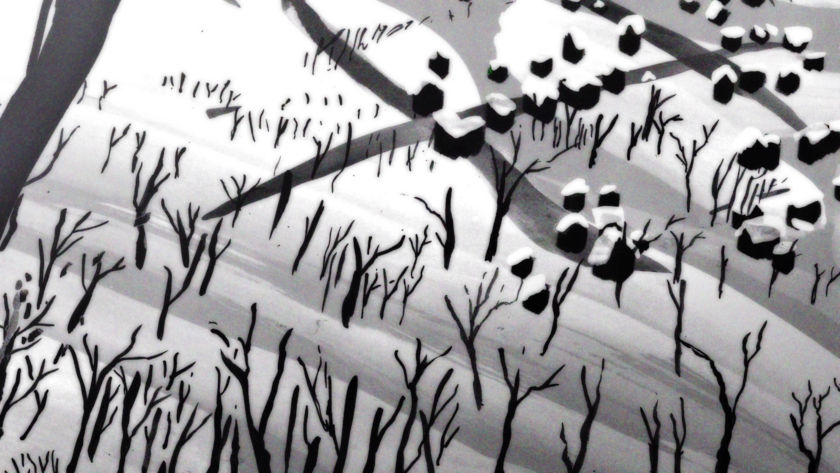
ZF: Most of your films are lengthier than the average animation short -but substantial nevertheless. Would you like to operate as a writer/director in this mid-length running time frame? Or do your stories always dictate the corresponding film length?
TP: I never plan the length of my movie (the only limitation is budget and eventual deadlines), I want to tell the story that I want to tell, and when it contains all I wanted then I see how long it takes. There is a rumor that festival selectioners prefer short movies, which makes sense programming-wise, but I believe if the content is good - it's good no matter the length.
ZF: How was the division of duties between you and Kasumi Ozeki? Was it the function of a 'second-unit' director or something different?
TP: Again I would use the word 'organic' as the way we worked. Kasumi was helping me much as a story and visual consultant. There is a big input of her in visual style (she proposed and convinced me to shift from a purely digital 3D workflow into a more handmade analog. Leaving aside obvious references to Japanese calligraphy and ink painting thanks to Kasumi's experience of working in an illustrator's agency and design company I learned the minimalist approach, also the value of asymmetry and accidents in composition. She edited parts of the movie like the Kulig sequence, especially I can trust her with music syncing, she drew some shots by herself where there was a special nuance to be grasped in the characters' faces. She was helping to organize gigantic Google sheets keeping track of work on 200+ shots of the movie. So my producer, Marcin Podolec proposed Secondary Director as her title in the movie, which covers the amount and variety of tasks and decisions she was performing.
Exclusive: Some Early Sketches for Tomek Popakul & Kasumi Ozeki's 'Zima'
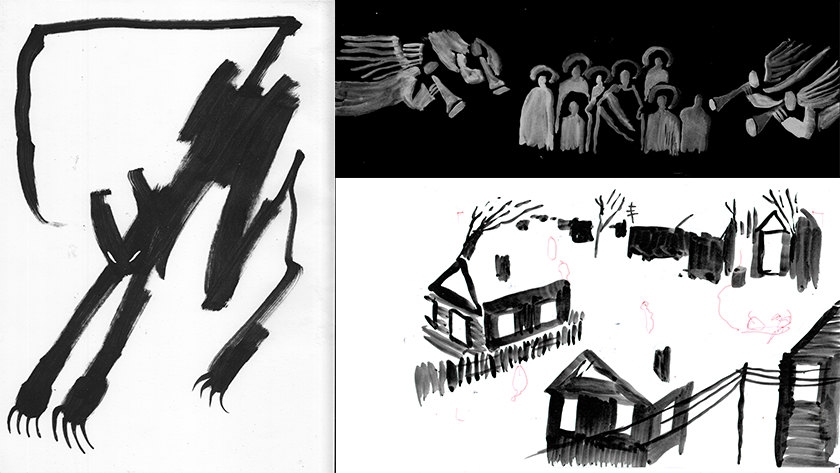
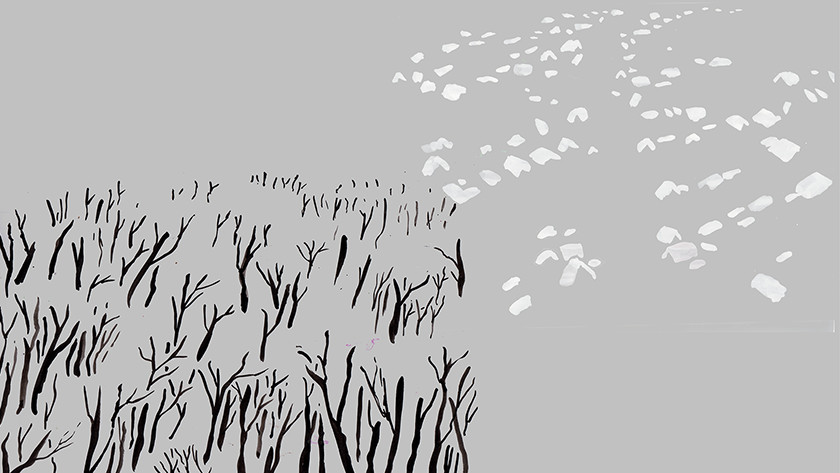
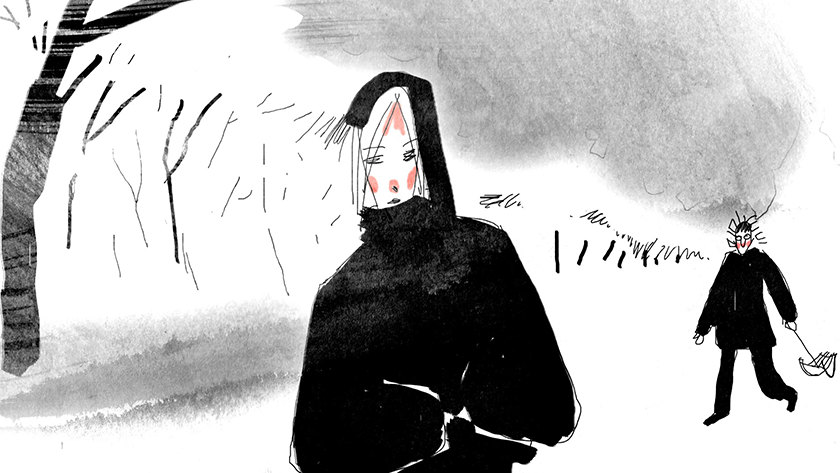
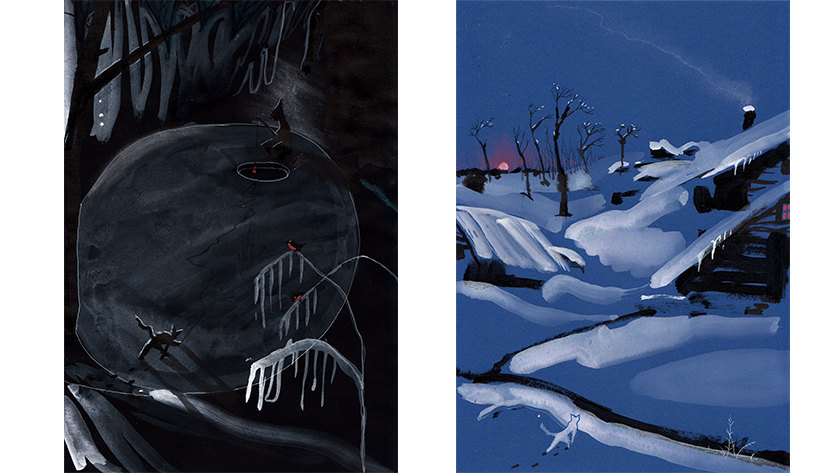
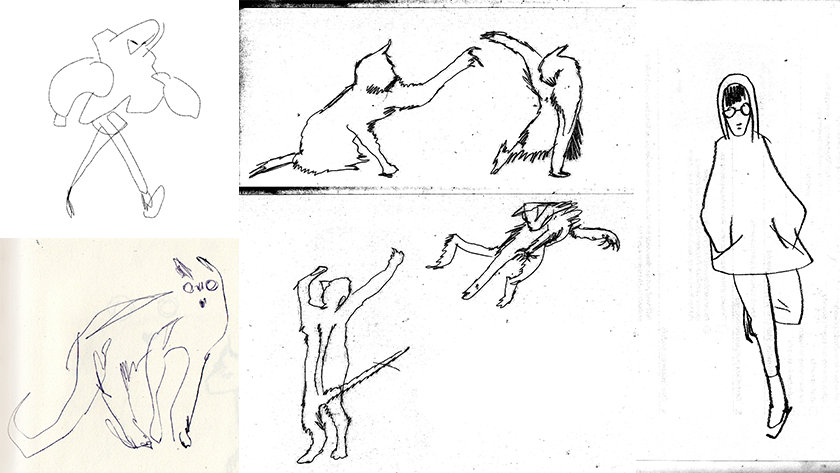
ZF: How do you organize your camera shots? Watching your film you feel like you dive with the characters into the unknown.
TP: I'm nerdy about cinematography in my movies; sometimes I can spend 1-week polishing of animation of camera movement in one shot. Easiness of operating with the camera is one of the things that I'm missing from 3D, but I still tried to keep this cinematic narration style in 'Zima' too.
ZF: The film has this 2D look, but 3D animation is here used as well. Can you give us an overview of how the whole thing was crafted in terms of animation and design?
TP: Character animation was much workaround to my poor drawing skills. In peak time we had up to 9 animators on the team who were trying hard to match my style of drawing, some of them I even asked to try drawing with my left hand. I can't draw faces with the same proportions from frame to frame, so certain line crookedness needed to be turned into a charm. Character animation was done on a tablet, although most of the backgrounds were hand-drawn on paper and scanned. For more dynamic scenes and unusual angles, I was indeed using rough 3D as a reference for the rotoscope, as well as live-action video recordings with my friends. Before 'Zima' I always claimed that I disliked analog textures in animated movies, feeling it's kind of fake when everything ends up in digital compositing, but I think with this movie I said 'sorry' to analog media, and I covered tons of paper sheets with smudges of ink. Now I like the vagueness of ink spots, leaving much space for viewers' imagination. The same brush stroke can depict a lake, tree, or cloud, depending on the context.
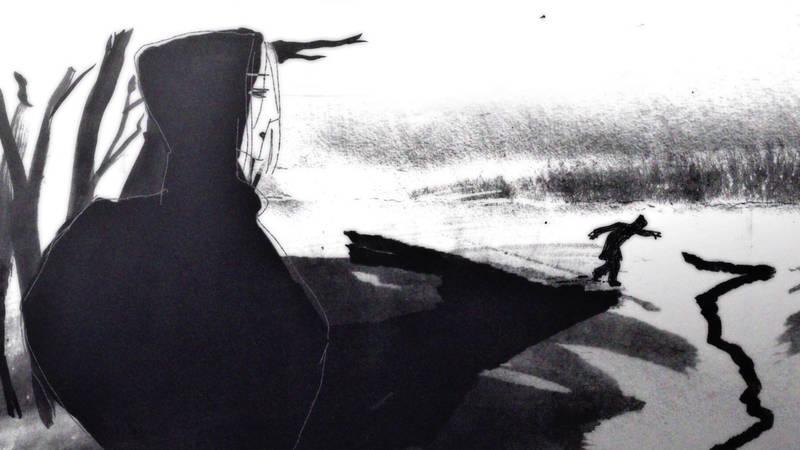
ZF: Music is here to stay in 'Zima', and the audience is meant to take notice of it, from rock/punk to choir and piano tunes. How did you choose your soundtrack?
TP: Soundtrack is one of the first things I have in mind when I start a new movie. The set playlist is ringing in my head setting the tone of the project even before any concrete story appears! Titles of songs, lyrics, and album cover art are always a big inspiration for me. In this case the 'headliner' was Godflesh, an industrial metal band from the UK, but also my beloved band 19 Wiosen with an organ solo by its keyboardist in the church scene. I listen much more to music than I watch movies.
ZF: 'Zima' takes place in an isolated habitat, and it's mostly a travelogue. Do you have the feeling that independent animation is sometimes an isolated habitat as well? Or do you have a completely different picture of the independent animation scene?
TP: The animation scene is an isolated habitat because there is a small number of people so weird and so determined to spend time on something like that. On the other side, it's isolated by mainstream perception of animation as mostly cartoons for kids, at most pop culture for teenagers. On the other hand, anime in Japan is omnipresent, and consumed by audiences of all ages and cultural backgrounds. Personally, I would want animation to aim to reach an adult audience. The community is small but dedicated and supportive. Being in touch with the live-action scene, and music scene, there is a relatively good atmosphere in it, as there are smaller egos because there is no big fame nor money to win in animation rather there's appreciation and value in craft animation.
Tomek Popakul and Kasumi Ozeki's 'Zima' (Winter) is an Oscar-qualifying film for the 2024 Academy Awards. For all 'Zima' ('Winter') updates, visit its Instagram page
The 'Zima' Poster
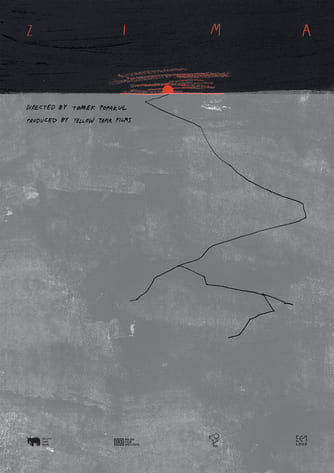
Credits:
'Zima', 2D animation, 2023 (26'26'', Poland)
WRITTEN AND DIRECTED BY Tomek Popakul | SECOND DIRECTOR Kasumi Ozeki | ANIMATION Jakub Baniak, Magdalena Basińska, Magdalena Botor, Alicja Błaszczyńska, Agnieszka Czachór, Jagoda Czarnowska, Patrycja Ćmak, Alicja Grotuz, Karolina Kajetanowicz, Olga Kłyszewicz, Marcin Kotliński, Adrianna Matwiejczuk, Agata Mianowska, Katarzyna Melnyk, Michalina Musialik, Maria Nitek, Michał Orzechowski, Marcin Podolec, Tomek Popakul, Weronika Szyma, Marcjanna Urbańska, Pola Włodarczyk | 3D MODELS AND ANIMATION Jacek Mazur, Krzysztof Rakszawski, Tomek Popakul | DESIGNED BY Tomek Popakul | EDITED BY Tomek Popakul | CREATIVE SUPPORT Yellow Tapir Films: Patrycja Ćmak, Agata Mianowska-Zamarło Marcin Podolec, Wiktoria Podolec, Konrad Sierzputowski, Kacper Zamarło | ACTORS Marek Beylin, Bartosz Bielenia, Tymon Jankowski, Stanisław Jaskułka, Maurycy Kiendziński, Mateusz Kmiecik, Janusz Komorowski, Maciej Malec, Nina Michnik, Anna Pyrka, Maurycy Stankiewicz, Bartosz Woch, Wojciech Wysocki, Magdalena Zawadzka | VOICES RECORDED BY Studio Praga | MUSIC Bluebird – c/o Kevin Richard Martin (King Midas Sound) „We Come Through the Sun” – Circle of Ouroborus „Life Giver Life Taker” – Godflesh, „BMW” – 19 Wiosen, „Soutu” – Tenhi, „Why” – AIT! | SOUND POSTPRODUCTION Sound Mind | SOUND DESIGNER / RE-RECORDING MIXER Michał Fojcik MPSE | SOUND EFFECTS EDITOR Barbara Kapica | FOLEY ARTIST Wojciech Iskierka | FOLEY MIXER Jan Rey | FOLEY EDITOR Bartłomiej Magdoń | PRODUCTION MANAGER Michał Benkes | PRODUCTION SUPPORT Konrad Sierzputowski | PRODUCED BY Yellow Tapir Films sp. z o.o., Marcin Podolec, Wiktoria Podolec | CO-PRODUCED BY „EC1 Łódź – Miasto Kultury” w Łodzi | Film co-financed by the Polish Film Institute © 2023 | Yellow Tapir Films / EC1 Łódź – Miasto Kultury
Cover Image: Tomek Popakul and Kasumi Ozeki.
Contributed by: Vassilis Kroustallis




